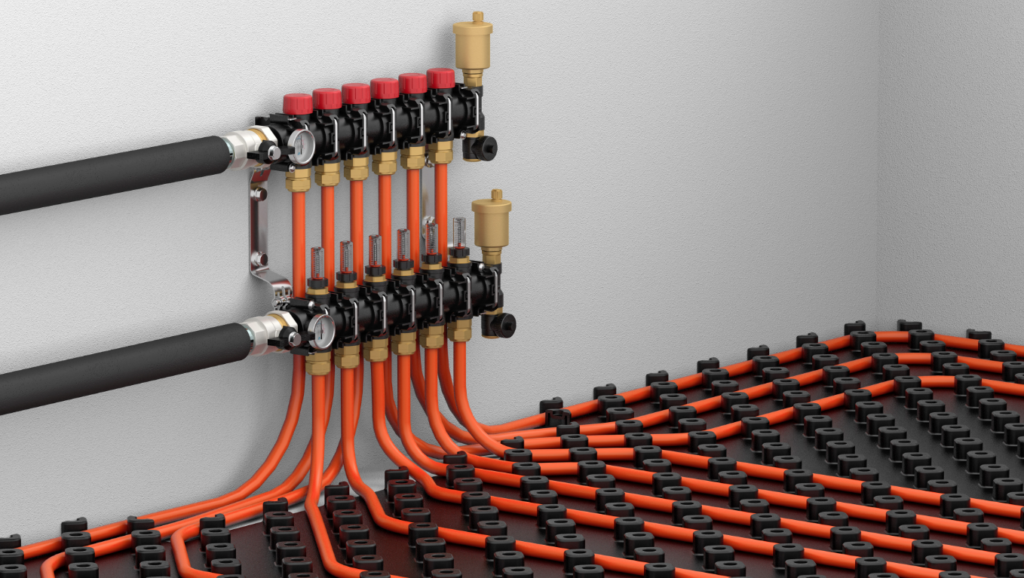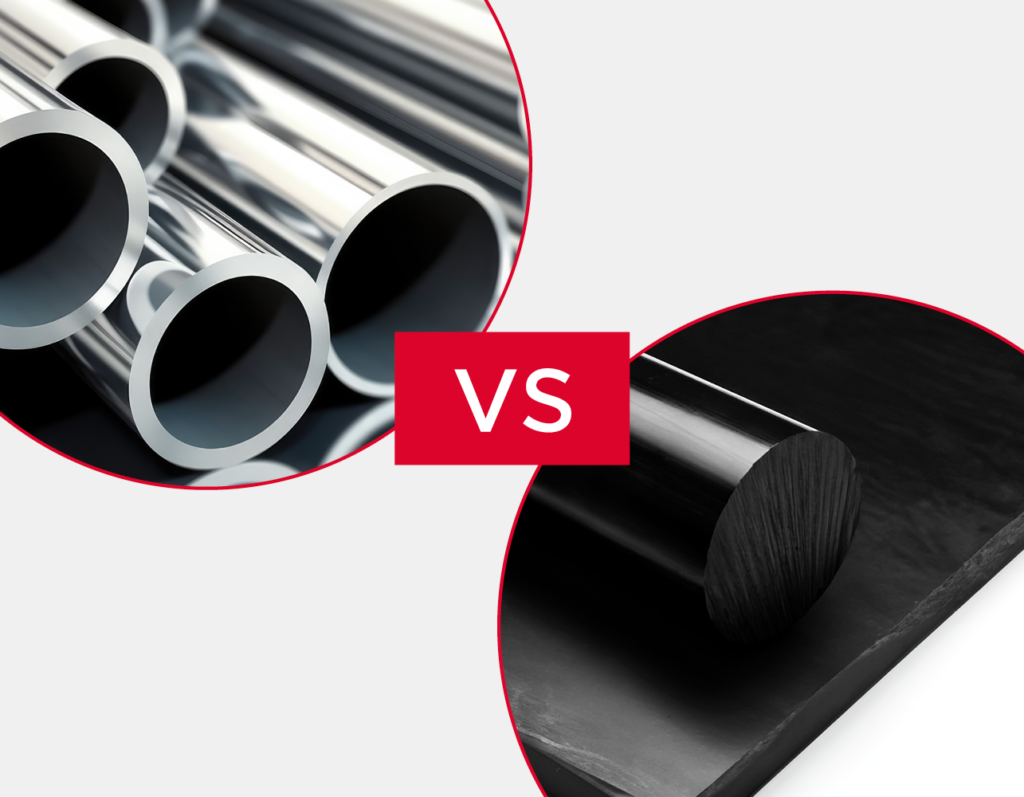The manifold is a crucial component of underfloor heating systems. It plays a vital role in distributing heat efficiently throughout the heated floor and enabling precise temperature control.
When installing a heated floor, the manifold is the first component to be installed before connecting to the system. This essential element is used in both residential and commercial underfloor heating systems. Make an informed decision for the right manifold for your installation. What should you consider from the variety of options available, each offering unique benefits? Read on…
Summary
Why is an underfloor heating manifold used?
A key component of the system
Manifold diagram and connectivity
Making the right calculations
Choosing your hydronic manifold
The four main varieties
Material
Insulation
Choosing between a monobloc and modular manifold
Finish: a guarantee of quality
Why is an underfloor heating manifold used?
A key component of the system
The purpose of an underfloor heating manifold is to distribute water evenly to each circuit loop based on demand, ensuring a consistent temperature throughout the system. However, if the collector circuits are poorly adjusted or compromised, the parts located on the last loops remain cold.
The manifold is positioned in a cabinet about 40 to 50 cm away from the floor.

Manifold diagram and connectivity
A manifold comprises two feeders. One is for supplying hot water to the floor loops (inlet bar) and the other for collecting the cold water that returns to the generator (outlet bar).
Other components of a manifold include:
- an air vent to eliminate air from the circuit;
- a draining valve;
- a thermometer;
- a transparent flow meter to adjust the flow of each circuit;
- ball valves – which allow for network maintenance without the need to remove the manifold;
- actuators – the most common type is connected to the thermostat and controls water flow by opening and closing the circuit.

⚠️ When selecting a range level, it is important to consider the raw material used and the options available, for instance the modularity.
Making the right calculations
When selecting a manifold for your project, it is important to consider the appropriate number of circuits. Manifolds can control between 2 and 12 circuits, which are located below the pipes. We recommend a maximum of 120 metres of tube per circuit.
📏 Aalberts hydronic flow control (Aalberts hfc) can assist you in the optimisation of manifolds by helping with calculations for selecting the right settings, determining the number of circuits and finding the appropriate size. Choosing your hydronic manifold
The four main varieties
When choosing a manifold, it is important to consider the following factors:
- Material: metallic or synthetic options
- Assembly: monobloc or modular options.
- A PA66 with 30 % fibreglass manifold has a thermal conductivity of 0.2 W/mK.
- For a stainless steel manifold, that number goes up to 16.3 W/mK.
The modular option consists of a bloc of one, two or three units that can be assembled as needed.
Here is a summary:
METALLIC SYNTHETIC Main material used Stainless steel Polyamide 6.6
+ fibreglass (according to type)
Risk of corrosion Yes – without additional insulation No Heat transmission performance + +++
Owing to high insulation
Suitable for cooling No – unless with extra insulation to prevent condensation Yes – it is recommended using 6 circuits maximum Assembly: modular option Limited designs available Yes Assembly: reversibility No Possible Material
If you are considering synthetic manifolds, it is important to note that not all are made from polyamide 6.6 and reinforced with 30 % of glass fiber.
🔴 Some synthetic manifolds are manufactured using materials that do not ensure the same level of quality.
Insulation
Heat transmission performance
The heat transmission performance of a manifold depends on its material. The less conductive the material, the more insulating it is. An insulating material has a thermal conductivity value of less than 4 W/mK.
Which manifold options transmit heat better? Therefore, synthetic manifolds have better heat retention properties, resulting in reduced water evaporation.
Managing condensation and corrosion in manifolds
Exposure to heat or cold (liquid around 16 °C) can result in condensation and subsequent corrosion. This can lead to premature wear and reduced performance of the product.
If you opt for a stainless steel manifold, proper insulation is crucial to minimize condensation and mitigate the potential for corrosion. Synthetic manifolds come pre-insulated, eliminating the risk of condensation and corrosion.
💡 Good to know If there are more than six circuits, it is necessary to use two manifolds. Choosing between a monobloc and modular manifold
A monobloc, which is a non-removable single block, lacks the versatility of a modular version. However, there are very few modular stainless steel collectors available. Still, why are modular manifolds an interesting option to consider?
Reversibility
In most cases, hot water is supplied from the left, although in bathrooms it is sometimes supplied from the right. A modular manifold offers the convenience of reversibility both vertically and horizontally, making it easy to install pipes in either direction.
Reversibility is not possible with a stainless steel manifold.
Adapt to the number of loops required on site
Even if the number of loops is calculated in advance, some projects may require more on site. If you need to increase the number of loops beyond the standard six circuits of a manifold, modular blocks allow you to easily add or remove modules on site to adapt to changing needs.
Limit stock
An advantage for wholesalers and suppliers is the ability to limit inventory. Instead of stocking manifolds with a range of 2 to 10 circuits (9 references), with modular collectors you only need basic kits and modules!
Finish: a guarantee of quality
When choosing a product, you should also consider the finish and design. In the case of feeders, be aware that the internal part where the tap is screwed in may have a sharp edge that could pierce the o-ring. Not all manufacturers certify or test their manifolds for quality assurance.
The Aalberts hfc guarantee
For over 20 years, our synthetic manifolds have been manufactured in Abbeville, France.
To ensure the highest level of quality and reliability, we have developed an advanced test bench to assess the performance of our manifolds. Our rigorous testing procedure spans 2,500 hours and includes subjecting them to alternating pressure bars and extreme temperatures, surpassing normal operating conditions.
The tests conducted are equivalent to the rigorous ones performed by ATEC (Advanced Test Equipment Corp), which expose manifolds to exceptional temperature and pressure to evaluate their resistance.
Pre-assembled models: a waterproof guarantee
At Aalberts hfc, we offer pre-assembled manifolds with rear mounting brackets to simplify installation and ensure watertightness. This eliminates the need for testing at this stage. And if any issues arise, we act as a reliable guarantor.
The modular manifold benefits greatly from this feature. Changing modules becomes effortless as you can simply remove a clip, saving both time and effort.
The manifold plays a crucial role in the proper functioning of an underfloor heating system. With several solutions on the market at different price points, it is important to consider the quality of materials and finishes to ensure durability and ease of maintenance. Investing in a good manifold will guarantee efficient and effective management of your underfloor heating system.
If you are planning an underfloor heating project in a renovation or new build, contact us for expert tips to help you make it a success.





